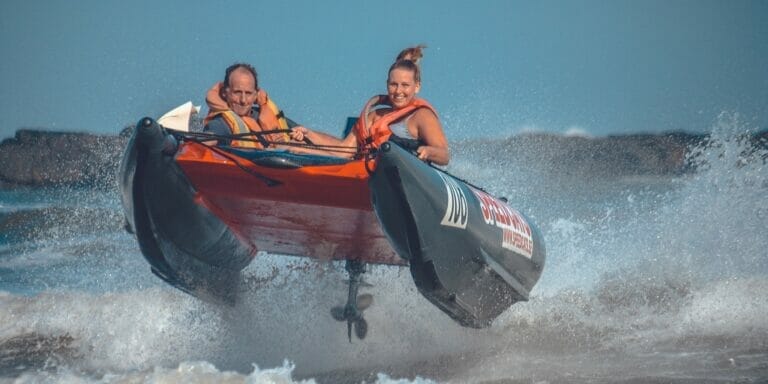You are interested in buying an inflatable boat? Maybe you have read our article in which we compare inflatable boats with conventional boats and now you are convinced to that an inflatable is preferable for you. This is certainly not a bad decision, because inflatable boats are used all over the world for a variety of purposes by many professionals such as the military or on research expeditions, due to their unique capabilities. We differentiate between Soft Inflatable Boats (SIBs) and Rigid Inflatable Boats (RIBs). SIBs can be completely disassembled, and the floor is usually made of wooden or aluminum plates, which are linked together and fixed in their position once the air chambers are inflated, thus giving the inflatable boat stability. RIBs, however, have a completely solid hull on which the tube is then attached. The hull itself is usually made of GRP (glass fiber reinforced plastic) and sometimes aluminum.
Now you are probably asking yourself whether a SIB or rather a RIB is more suitable for you. Well, this is exactly the question we want to deal with in the following.
SIBs
The Soft Inflatable Boat (SIB) can be completely disassembled, as it does not have a rigid hull. Instead, the hull of SIBs is constructed either from floor plates that are linked together (usually made of aluminum or wood) or, on smaller SIBs, sometimes even from a high-pressure inflatable floor. By inflating the tube, the SIB still achieves incredible stability and is in no way inferior to many rigid hull boats of the same size.
SIBs find many applications due to their enormous flexibility, from use as a dinghy to a fast speedboat. It is also particularly popular with newcomers to the world of boating.
Advantages
Ability to Disassemble
The first and truly unique advantage is obvious: SIBs can be completely disassembled and reduced to a small package size for transport or storage. This is especially relevant for people who use their boat only seasonally or for those who like to take the boat on a trip without having to rely on a trailer.
Light as a Feather
In addition, SIBs are extremely lightweight, which also makes them easier to transport, launch, and to handle in general. People who plan to launch their boat on their own will appreciate the light weight.
Low Draft
In many cases, the draught is also less than with a RIB, since there is no deep V hull. The draft may be negligible in smaller boat sizes, but in some applications, this can be an advantage.
In circumstances like those shown in the image below, a SIB is certainly advantageous.
Great Affordability
In addition, SIBs are much more budget-friendly when compared to RIBs. In general, you often find an excellent price-performance ratio, because you can enjoy all the advantages of an inflatable boat without having to dig deep into your pocket.
Disadvantages
Reduced Stability
In direct comparison to the RIB, a SIB offers less stability due to the lack of a rigid hull. Here, we do not mean primarily the lateral tilt stability, but rather the stability that comes into play when you’re surfing through waves.
Inferior Rough Water Performance
Following this disadvantage, we note that a SIB has much poorer rough water capabilities. This is mainly due to the fact that a SIB does not have a proper V-hull and thus tends to slap on the waves instead of breaking them. In addition, the SIB is extremely low on the water and therefore waves are more likely to slosh into the boat. However, this is usually not too dramatic, since the tubes provide plenty of buoyancy, just everything gets soaked.
Performance Issues at Higher Speeds
The lack of a V-hull has another disadvantage which is that the tubes get sucked down to the surface of the water at higher speeds around 25 knots. However, this phenomenon does not occur with all models, because it depends on several factors. In addition, this problem usually only occurs with heavily overpowered SIBs, because most boats do not even reach this critical speed range at recommended engine power.
Low Inner Board Height
In addition, a SIB has a very low inner board height, which is particularly relevant if you have small children on board. Also, the floor connects directly to the tubes, in contrast to a RIB, where the floor usually has a small offset before it connects to the tube. This has the advantage that any sharp objects (such as harpoons) do not damage the tubes when transported on the deck. Here you should really pay attention, because even seemingly harmless objects can damage the tube through continuous rubbing.

Special Case of SIB: Hull with Speed Tubes
At this point we also want to point out a special form of the SIB, namely those models, which have two so-called speed tubes (also known as hijackers) on their hulls. You can imagine them like a catamaran, because on the bottom of each side tube is this additional air chamber (the speed tube), which functions like a skid. As soon as the boat lifts out of the water at planing speed, it only has water contact with these speed tubes. This reduces friction while providing tremendous lateral stability even at higher speeds. In addition, air is compressed under the hull between the two speed tubes which provides additional buoyancy and creates a kind of air cushion between the water and the hull which improves comfort.
This particular hull concept is found mainly in the catamaran-style inflatable boats known as Thundercats (or often called Zapcat, but this term refers only to a specific model of one single manufacturer, called “Gemini”).
The following image shows the catamaran-like hull of a Gemini Zapcat.
However, a few manufacturers also offer conventional SIBs with such speed tubes. Probably the best-known manufacturer is Zodiac, which equipped the Futura model line with speed tubes like these. However, Zodiac seems to have dropped the Futura series from its product line and only offers this special hull shape under the name Zodiac Milpro, which is aimed at professionals and the military.
In the image below you find the Zodiac Milpro FC 470 where you can also see the speed tubes under the main tubes if you look closely.
The huge advantage of this type of SIB is that the performance of the boat is increased dramatically, and, with a sufficiently high motorization, high speeds can be achieved, because you do not have the above-described problem of the tubes getting sucked onto the water surface. In addition, the skid-like speed tubes ensure that the boat runs like on rails and thus provides great handling in tight turns. We can’t really identify any real disadvantages compared to a conventional SIB with inflatable center keel. The maximum payload may be slightly lower in some cases. In addition, the supply of such special SIBs is very limited, and the prices are usually higher than for conventional models. However, if you get the opportunity to get such a boat and you intend to focus on performance with a suitable high motorization, we can highly recommend these SIBs with speed tubes.
We even dedicated a whole article to this special type of SIB that you find here. LINK
RIBs
A Rigid Inflatable Boat (RIB), or sometimes called a Rigid-Hulled Inflatable Boat (RHIB), is a boat that is constructed of both a rigid hull and an inflatable tube that goes all the way around. The rigid hull is mostly made of GRP or in some cases of aluminum. The hull shape is usually in V-shape, but there are also a few models with alternative hull shapes such as a twin hull (catamaran).
In general, RIBs are very seaworthy and occasionally referred to as the SUVs of the sea. Many professional users such as the military or police rely on RIBs as well due to their outstanding riding characteristics.
Advantages
Increased Hull Rigidity
In contrast to a SIB, the hull hardly twists at all, even under high loads, thus offering significantly improved driving stability. This is especially important in rougher water conditions, which brings us directly to the next advantage of a RIB.
Fantastic Rough Water Capabilities
RIBs are known to have one of the best rough water characteristics of any boat type. The unique combination of a massive wave breaking V-hull and the absorbent tube that runs around it, offers the best of both worlds, and allows for excellent performance in rough sea conditions. In addition, due to its construction, a RIB is generally higher above the water level, which allows for a drier ride.
High Speed Potential
The V-hull of a RIB prevents the tube from getting sucked down at higher speeds, as described above for SIBs. Again, the tube harmonizes perfectly with the rigid hull because the tubes make it easier to lift the hull out and stabilize it laterally at higher speeds in the rear third of the hull where there is still some contact between the tube and the water.
Higher Motorization
In general, RIBs also allow for higher motorization than comparable SIBs, which again means their performance is simply a lot of fun. The ratio between weight and allowed engine power is really unbeatable when it comes to RIBs and only a few other boat types can compete with that.
Higher Inner Board Height
Basically, most RIBs offer a greater inner board height, which on the one hand is advantageous if you have small children. On the other hand, it simply offers a great tub-like experience that gives you the feeling of sitting in the boat rather than on it. Furthermore, the offset between the deck and the connection with the tubes provides an excellent possibility to transport all kinds of objects on deck without damaging the tube. However, there are big differences between different manufacturers and therefore, if this feature is relevant for you, you should pay attention to such small but significant differences when choosing your boat.
Convenience of the Rigid Hull
Another point is that most RIB hulls have a bow compartment integrated which is lockable and at the same time can be used as a seating area and is also helpful when getting in and out of the boat. In addition, the solid hull allows additional, permanently mounted attachments which can be quickly and easily glued or screwed to the hull. This also allows for easier installation of equipment, solid seats, or sunbathing areas on the RIB.

The Sky’s the Limit
In the world of RIBs, there is nothing that does not exist. The sky’s the limit in terms of size, performance, and luxury, provided you have the wherewithal. It’s amazing what manufacturers come up with…
Disadvantages
Bulkier Storage Dimensions
The first disadvantage is also obvious here: unlike the SIB, the RIB cannot be completely disassembled. You can only reduce the dimensions a little by letting the air out of the tubes and then folding them to the inside as best you can.
More Weight
The rigid hull obviously comes with some extra weight. How significant this additional weight is, depends on the exact hull shape, the hull material, and the hull stability. On the one hand, hulls with a particularly deep profile weigh considerably more than moderate hulls, which on the other hand have inferior rough water qualities. Aluminum hulls are generally lighter than those made of GRP, and some manufacturers use thinner material than others, which saves weight but comes at the expense of strength.

More Draft
In displacement mode at slow speeds, when the hull is not yet elevated out of the water, the hull of the RIB sits deeper in the water than that of a SIB and therefore the draft is slightly greater. In very shallow water, this small difference in draft can be quite critical.
Higher Cost
RIBs are significantly more expensive to purchase than SIBs. In addition to the tube, the hull must also be maintained (e.g., gelcoat and antifouling) which increases the maintenance costs compared to a SIB. However, this additional expense is not really significant for smaller boats and is more of an issue for larger boats.
A Summarizing Overview
In the two tables below, we have once again summarized the respective advantages and disadvantages of SIBs and RIBs in an overview.
SIBs
| Advantages | Disadvantages |
|---|---|
| Ability to Disassemble | Reduced Stability |
| Extremely Lightweight | Inferior Rough Water Performance |
| Low Draft | Performance Issues at Higher Speeds |
| Very Affordable | Low Inner Board Height |
RIBs
| Advantages | Disadvantages |
|---|---|
| Increased Hull Rigidity | Bulkier Dimensions |
| Superior Rough Water Capabilities | More Weight |
| High Speed Potential | More Draft |
| Higher Motorization | Higher Cost |
| Higher Inner Board Height | |
| Convenience of Rigid Hull | |
| The Sky’s the Limit |
Important Notes Regarding the Size of the Boat
Bigger Boats
When considering whether to choose a SIB or a RIB, the length of the boat you require plays an important role, because from around 5 meters upwards, this question usually no longer arises, as the RIB will most likely meet your requirements better in every respect. In addition, the available choice of SIBs above this size class diminishes rapidly. In a few very special use cases a SIB may still be preferable, but those with such unusual requirements are unlikely to need this guide here on Maritime Affection…
A Well-Intentioned Advice
This advice is especially for those who are relatively new to the world of boating. From experience we can say that for many newcomers it has proven to start small and then later, when you have already gained experience, move to larger boats. Typically, many buy a small, inexpensive SIB as a first step to see if they really enjoy it. In most cases this is the case, and then it is time to move up to a larger SIB or even a RIB. Such an approach has proven to be very successful, because with a SIB you have a very low initial investment and you don’t have to make any long-term commitments, such as renting a berth. We have even written a dedicated post in which we advise you on the purchase of your very first boat, feel free to check it out for more information.
Now it’s your turn!
We hope we could give you a good overview of the different types of inflatables, and now it’s your turn. With the advantages and disadvantages listed, you should now be able to decide what makes most sense for you based on your personal needs and constraints. Take your time, because researching and thinking about you purchase will give you a lot of anticipation and that only adds to the joy of boating!
If you’re having a hard time deciding and would like to hear our personal advice, just get in touch in the comments or also feel free to use any of our various contact options. We are happy to help you! The same goes for you if you have something to add or criticize. Just write it in the comments, then everyone can take part in the discussion.
Oh, and it’s definitely worth checking out our article on Thundercats, because we really fell for these speedsters.















